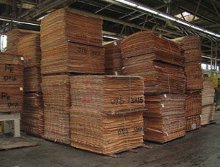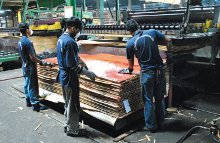Administering CPR
23 February 2013With the timber industry’s focus firmly fixed on the forthcoming EU Timber Regulation, attention has been diverted from the new Construction Products Regulation but, as John Park explains, both will have an impact on the plywood sector
In all the recent rhetoric about the EU Timber Regulation (EUTR) and how it will affect, among others, the plywood sector, there has been very little mention of the Construction Products Regulation (CPR) and of the new legal obligations to be imposed on importers and distributors from July 1 this year.
For your own copy of Construction Products Regulation - a cracking read for the Easter holidays - visit eur-lex.europa.eu/LexUriServ/ LexUriServ.do?uri=OJ:L:2011:088:0005:0043:E N:PDF or simply google 'EUROPA CPR'.
In summary, Article 13 of the CPR sets out the obligations of importers:
? Importers shall place on the Union market only construction products which are compliant with the applicable requirements of this Regulation.
? Before placing a construction product on the market, importers shall ensure that the assessment and the verification of constancy of performance have been carried out by the manufacturer. They shall ensure that the manufacturer has drawn up the technical documentation referred to in the second subparagraph of Article 11(1) and the declaration of performance in accordance with Articles 4 and 6. They shall also ensure that the product, where required, bears the CE marking, that the product is accompanied by the required documents and that the manufacturer has complied with the requirements set out in Article 11(4) and (5).
Meanwhile, Article 14 sets out the obligations of distributors:
?When making a construction product available on the market, distributors shall act with due care in relation to the requirements of this Regulation.
? Before making a construction product available on the market distributors shall ensure that the product, where required, bears the CE marking and is accompanied by the documents required under this Regulation and by instructions and safety information in a language determined by the Member State concerned which can be easily understood by users. Distributors shall also ensure that the manufacturer and the importer have complied with the requirements set out in Article 11(4) and (5) and Article 13(3) respectively.
So while CE marking of construction products in the UK is currently voluntary, from July 1 it becomes mandatory.
In addition, before the CE mark can be applied, the producer must first raise a Declaration of Performance (DoP) (currently this is a Declaration of Conformity under the CPR's predecessor, the Construction Products Directive (CPD)), set out as stipulated in the 'model' layout provided within the CPR.
Plywood comes under EN 13986, the harmonised standard for wood-based panels, which at present is under review. Because the new version won't be ready in time, the current version will stay in existence until July 1 next year and will only be CPD compliant with an annex ZA, which will not be CPR compliant. So manufacturers will have to comply with the new CPR requirements based on the superseded CPD requirements. Clear so far?
At present it can be impossible to get any clear indication of wood species used in plywood, with "mixed species" often satisfying current expectations. Part of the EUTR's due diligence requirements is identification, and in some cases quantification, of wood species.
If the manufacturer can only identify the wood they have used as "mixed species" then, under the EUTR, each species and variety within that mix must be individually identified. This is simply perfect for plywood as it will enable the natural biological durability of the plywood to be determined by reference to EN 350 Part 2. The natural biological durability of the plywood will be that of the least durable of the species or variety listed within their mix. And if the manufacturer cannot guarantee that sapwood has been excluded, the default natural biological durability will be "not durable". If any species in the mix is not listed in EN 350-2, then someone will have to carry out testing in accordance with EN 350-1 to determine the natural biological durability, or the declaration will be the default "not durable".
The vexed issue of plywood natural biological durability has been variously addressed in EN 636, but with little success. What was not appropriately addressed has at last been recognised and we are endeavouring to put it right.
The current approach of using Use Class (the end-use condition) as a means for the manufacturer to declare/indicate the natural biological durability of plywood (eg EN 636-2) is not only completely illogical (it is not a material property) and misleading but also entirely unsafe. For glue bond, on the other hand, it is entirely logical as it is used as a determining factor for the material property of a glue bond and is what EN 314-Part 2 references for glue bond.
EN 636 is a standard for the manufacture of plywood and not its use. The requirements for glue bond and natural biological durability being two distinct and, in essence, unrelated aspects of the manufacture of plywood, should be addressed in separate clauses. This also, and quite appropriately, will provide the manufacturer with the opportunity to declare an exterior glue bond (marking their plywood EN 636-3), even when using a wood species with lower, including "not durable", natural biological durability. Use of EN 636-1, EN 636-2 and EN 636-3 will be as the reference to glue bond only.
The subsequent use of plywood, either with (enabling plywood to be used in the more onerous Use Classes in the way they have been for many years and particularly plywood manufactured with wood species with high strength but low natural biological durability) or without the application of an appropriate preservative treatment or coating system, is contingent on the designer or specifier knowing the make-up of the plywood. TS 1099 is the guidance document developed to assist designers and specifiers in this regard, but its use relies on the provision, by the plywood manufacturer, of complete and concise details of wood species used. Enter the EUTR.
The forthcoming adoption of the CPR provides the ideal opportunity for the incorporation, into EN 636, of the revised approach and the disassociation of glue bond from natural biological durability.
Under the CPR, importers and distributors are legally obliged to obtain and pass on the Declaration of Performance with all that new information in it. This will ensure that everyone along the supply chain will be fully conversant with the revised approach in a very short time.
And no bona fide plywood manufacturer can possibly object to any of the above - all of it is to their best advantage. And we will be able, once and for all, to get rid of the ridiculous use of CE2+ as if it were a specification!



